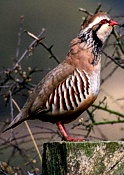|
|

|
|
Chukar  Usually pronounced "chucker" in the U.S., the name is often attributed to the
"chuck-chuck-chukar" song that the birds make, usually just before they
move out on the ground or on the wing. It's been said that
the first time you hunt chukar is for fun, adventure, and a nice meal on the table
(see some of our favorite chukar recipes),
and thereafter, it's entirely about getting even (because that first hunt can be
a real challenge!). Usually pronounced "chucker" in the U.S., the name is often attributed to the
"chuck-chuck-chukar" song that the birds make, usually just before they
move out on the ground or on the wing. It's been said that
the first time you hunt chukar is for fun, adventure, and a nice meal on the table
(see some of our favorite chukar recipes),
and thereafter, it's entirely about getting even (because that first hunt can be
a real challenge!).
First brought into the U.S. by Illinois game breeders in the late 1890's the Chukar Partridge originates in southern Asia. Midwest and western states expiremented with large scale releases of these birds during The Great Depression, and that produced flocks of various sizes in Nevada, Minnesota, Wisconsin, California, Idaho, and Washington state. In Great Britain, hybrids between this species and the also introduced Red-legged Partridge are common. The releases were hit and miss, with some being abject failures. After some years of figuring out what sort of terrain and climate appealed to these birds, we're now looking at healthy populations that reproduce in the wild and thrive in fairly large numbers. Chukar are routinely used as training birds, and thus many are released into areas that may not, in the long term, support a wild population. Chukar like rocky, vertical terrain, and will fly well from traps and other ground plantings when suitably annoyed. Once they're in their home turf, though, it can be some rough hunting. Bird dogs can easily get injured seeking and retrieving chukar in their preferred environments, so be thoughtful about your approach, and caution your dog. When these birds are spooked on their home ground (usually a rocky hillside), they'll either run up the hill in search of stoney cover, or fly downhill, using the drop to put on a burst of serious speed to elude their foe. You can use your awareness of those tactics to better place gunners and dogs when approaching a hilly hotspot. The Chukar (Alectoris chukar), is a gamebird in the pheasant family Phasianidae of the order Galliformes, the gallinaceous birds. This partridge has its main natural range in southeastern Europe, and is the eastern equivalent of the similar Red-legged Partridge (Alectoris rufa). A resident breeder in dry, open and often hilly country, it nests in a barely lined scrape in the ground, usually laying 8-20 eggs. Chukar eat some insects for protein, and a wide variety of seeds. This is a chubby, powerful bird, with a light brown back, grey breast and buff belly. The face is white with a black gorget. It has rufous-streaked flanks and red legs. When disturbed, it prefers to run rather than fly, but if necessary it flies, abruptly and swiftly, a short distance on rounded wings. The relative bulk of the bird means it takes a moment to really get moving, which provides hunters with a fairly close-in shot. The chukar is very similar to Rock Partridge (Alectoris graeca), but is browner on the back and has a yellowish tinge to the foreneck. The sharply defined gorget distinguishes this species from Red-legged Partridge. The song is a noisy "chuck-chuck-chukar-chukar" that can be heard a surprising distance. Some Chukar Hunting Tips:
Browse The EU Here: A-C | D-F | G-I | J-L | M-O | P-R | S-V | W-Z |
|
^Top | Home | About UplandLife.com | Contact Us | Advertising/Listings | Privacy / Policies | Site Map Entire contents copyright © 2024 UplandLife.com, All Rights Reserved. Content Technology From NorseCode. |